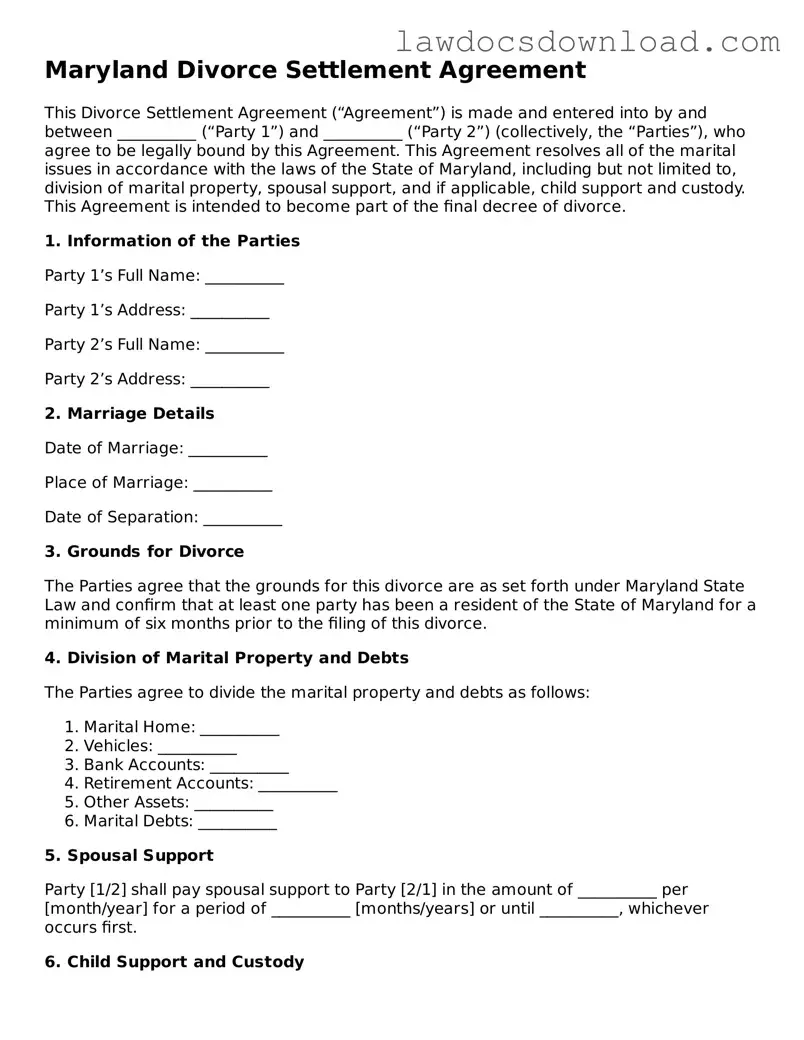The Maryland Divorce Settlement Agreement form is similar to the Marital Settlement Agreement, which outlines the division of assets, debts, and other financial obligations between spouses. Both documents serve the same purpose, allowing couples to agree on the terms of their separation and avoid contested court battles. The details include how property is divided, whether spousal support will be paid, and the arrangement for any children involved.
Comparable to the Custody Agreement, this form addresses issues related to the care and welfare of the children from the marriage. Both documents outline the terms of where the children will live, visitation schedules for the non-custodial parent, and how decisions about the children's education, health, and welfare will be made. The primary focus is ensuring the children's best interests are considered and agreed upon by both parties.
Similarly, the Child Support Agreement is another document that shares common ground with the Maryland Divorce Settlement Agreement form. It specifically zeroes in on the financial responsibilities each parent will have towards their children. This includes how much, how often, and by what means child support payments will be made. Both agreements seek to ensure that adequate support is provided for the children's needs.
Like the Alimony Agreement, the divorce settlement form includes arrangements regarding spousal support. Both documents determine if one spouse will provide financial support to the other, the amount of support, and the duration. This is especially important in cases where there is a significant disparity in the income or earning potential between the spouses.
The Property Settlement Agreement shares similarities with the divorce form, focusing on the division of the couple's assets and debts. This involves detailed arrangements on who gets what, including homes, vehicles, investments, and even personal belongings. Both aim to fairly distribute the marital property, considering each spouse's contributions and needs.
Another related document is the Separation Agreement. Before a divorce, some couples opt for a legal separation, detailing how they will live separately while remaining legally married. The separation agreement covers similar ground as the divorce settlement form, including financial arrangements, custody, and support, setting the stage for a smoother transition to divorce if that path is chosen.
The Pre-nuptial Agreement, though executed before marriage, can influence the terms of a Divorce Settlement Agreement. It typically outlines how assets and debts will be handled in the event of a divorce. If upheld, it can significantly shape the distribution of property, spousal support, and other elements in the divorce settlement, aligning with previously agreed-upon terms.
Post-nuptial Agreements, similar to pre-nuptial ones but executed after marriage, can also resemble the divorce settlement form in content and function. These agreements may revise or establish new terms regarding the couple's finances, property, and obligations to one another, which can directly affect the conditions of their eventual divorce settlement.
Lastly, the Financial Affidavit is a document often used in conjunction with the Divorce Settlement Agreement to provide a comprehensive view of each spouse’s financial situation. It lists incomes, expenses, assets, and debts, offering a factual basis for the discussions and decisions about financial support, asset division, and other economic matters in the divorce settlement.
